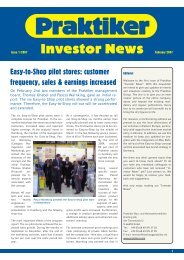Praktiker Bau- und Heimwerkmärkte Holding AG, Kirkel
Praktiker Bau- und Heimwerkmärkte Holding AG, Kirkel
Praktiker Bau- und Heimwerkmärkte Holding AG, Kirkel
Create successful ePaper yourself
Turn your PDF publications into a flip-book with our unique Google optimized e-Paper software.
Risk report<br />
Page 18<br />
The management board of <strong>Praktiker</strong> <strong>Holding</strong> <strong>AG</strong> has implemented a cross-group risk management<br />
system. The risk management system serves the purpose of risk identification as well as risk elimination<br />
or mitigation and encompasses all <strong>Praktiker</strong> <strong>Holding</strong> <strong>AG</strong>’s corporate divisions and all corporations<br />
belonging to the <strong>Praktiker</strong> Group.<br />
Business activities are subject to risk by virtue of their very nature. Internal risk management guidelines<br />
are characterised by the concept that no action or decision may expose the group to an existential<br />
risk. If risks cannot be avoided, they must be insured to the extent possible and economically feasible.<br />
Residual risks must be controlled by using risk management tools.<br />
The principles <strong>und</strong>erpinning this risk management system are documented in a risk management<br />
manual for the group compiled by the management board. It contains the organisational and procedural<br />
f<strong>und</strong>amentals applying both to the group’s German operations and to its foreign-based subsidiaries.<br />
As such, the management board complies with its responsibility in respect of the stipulation of the<br />
risk management principles and the organisational setup of the risk management system. In this connection,<br />
the management board also assumes the duty of providing the supervisory board and the<br />
shareholders with the necessary information. Immediately below management board level, a risk<br />
management officer coordinates risk reporting activities throughout the group. The risk management<br />
coordinator is above all responsible for the further development of the risk management system, for<br />
risk reporting coordination and for drawing up the monthly risk reports for the management board.<br />
These reports keep the management board informed about any key changes in the risk landscape and<br />
developments in risk management as well as about the measures taken in terms of risk mitigation or<br />
prevention.<br />
The heads of the divisions are responsible for identifying, logging and valuing the respective risks of<br />
their division. It is their duty to control and monitor the risks applying to the part of the business they<br />
are in charge of. For this purpose, a standardised risk matrix is used and updated on an ongoing basis.<br />
It features all key risks together with their probability of occurence and potential financial implications.<br />
Countermeasures for potential and existing risks are defined for each corporate division. The<br />
manner in which the individual risks have developed and the nature of the countermeasures taken are<br />
documented too.<br />
Every six months, the risk management officer carries out a risk inventory, taking account of all risk<br />
reports and changes relevant to the given risk assessment. The results are submitted to the management<br />
board in the form of an extract from the risk inventory of all key risks.<br />
The process-independent monitoring of the risk management system is the responsibility of <strong>Praktiker</strong><br />
Group’s internal audit department, which examines the risk management system in terms of its functionality<br />
on a yearly basis.



